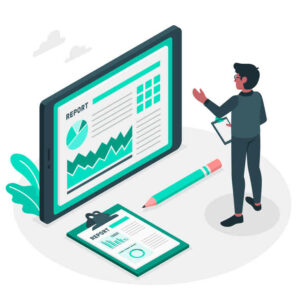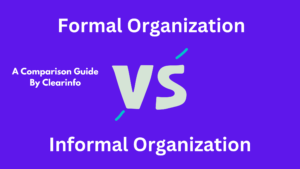Many professionals struggle to create effective reports due to a lack of understanding of the essential elements and organization required. This can lead to frustration and a failure to communicate key information to the intended audience.
In this blog, we’ll explore what is report writing, the types of reports, essential elements, and tips for creating effective reports to help you communicate your message and achieve your goals.
Definition of report writing?
According to Mary Munter and Lynn Hamilton, authors of “Guide to Managerial Communication,” report writing is “the process of selecting, organizing, interpreting, and communicating information to meet a specific objective.”
What is report writing?
Report writing refers to the process of creating a document that represents information in a clear and concise manner. Reports can be written for various purposes, such as providing updates on a project, analyzing data or presenting findings, or making recommendations.
Effective report writing requires careful planning, research, analysis, and organization of information. A well-structured report should be accurate, and objective, and contain a clear introduction, body, and conclusion. It should also be written in a professional and accessible style, with appropriate use of headings, subheadings, tables, graphs, and other visual aids.
Overall, report writing is an important skill for professionals in many fields, as it helps to communicate information and insights in a clear and concise manner.
What is a report?
A report is a formal document that is structured and presented in an organized manner, with the aim of conveying information, analyzing data, and providing recommendations. It is often used to communicate findings and outcomes to a specific audience, such as stakeholders, or managers. Reports can vary in length and format, but they usually contain a clear introduction, body, and conclusion.
Types of report writing
By understanding the different types of report writing, individuals can select the appropriate format and structure to effectively communicate information and achieve their objectives. However, the kind of report used will depend on the purpose, audience, and context of the report.
1/ Informational reports: These reports provide information about a topic, such as a product, service, or process.
Further Reading: What is an information report
2/ Analytical reports: These reports present data or information in a structured and organized manner, often with charts, graphs, or tables, to help the reader understand trends, patterns, or relationships.
3/ Formal Reports: These are detailed and structured reports written for a specific audience, often with a specific objective. In comparison with informal reports, formal reports are typically longer and more complex than other types of reports.
4/ Progress reports: These reports provide updates on a project or initiative, detailing the progress made and any challenges or obstacles encountered.
5/ Technical reports: These reports provide technical information, such as specifications, designs, or performance data, often aimed at a technical audience.
6/ Research reports: These reports present the findings of research conducted on a particular topic or issue, often including a literature review, data analysis, and conclusions.
7/ Feasibility Report: A feasibility report assesses the likelihood of achieving success for a suggested project or initiative.
8/ Business Reports: These reports are used in a business setting to communicate information about a company’s performance, operations, or strategies. Different types of business reports include financial statements, marketing reports, and annual reports.
Structure of report writing
The structure of a report refers to the overall organization and layout of the report, including the sections and subsections that make up the report, their order, and their relationships to each other. A report can we divided into three parts.
Preliminary Parts:
- Title page
- Date
- Acknowledgments (Preface or Foreword)
- Table of Contents
- List of Tables and Illustrations
Main Text:
- Introduction (clear statement of research objectives, background information, hypotheses, methodology, statistical analysis, scope of study, limitations)
- Statement of findings and recommendations (summarized findings, non-technical language)
- Results (detailed presentation of findings with supporting data in the form of tables and charts, statistical summaries, and reductions of data, presented in a logical sequence)
- Implications of the results (clearly stated implications that flow from the results of the study)
- Summary (brief summary of the research problem, methodology, major findings, and major conclusions)
End Matter:
- Appendices (technical data such as questionnaires, sample information, and mathematical derivations)
- Bibliography of sources consulted.
This structure provides a clear and organized framework for presenting a research report, ensuring that all important information is included and presented in a logical and easy-to-follow manner.
Extra Learnings
Role of a report structure in report writing
The report structure plays a crucial role in report writing as it provides a clear and organized framework for presenting information in an effective and logical manner. It ensures that the reader can easily understand the purpose and scope of the report, locate and access the relevant information.
The preliminary parts of the report, provide an overview of the report and aid navigation. The main text makes it easier for the reader to comprehend and analyze the information. And The end matter provides additional details and sources for reference. An organized report structure also helps the author to communicate their research and ideas effectively to the intended audience.
What is the report writing format?
The format of report writing refers to the structure of a formal document that provides information on a particular topic or issue. The report writing format typically includes the following key components:
8 Essential elements of report writing are:
1/ Title: The title is the first thing that readers will see, and it should be clear and concise. The title should include the report’s subject or topic and the author’s name, date of writing, or who the report is for. Remember to keep the title brief and informative, avoiding vague or ambiguous language.
Example of Business Report Title Page:
“Market Analysis and Growth Strategies for XYZ Corporation”
Author: Mary Johnson
Date: January 2, 2022
Company: Earthcon Corporation
Department: Strategy and Planning
In this example, the title page includes the name of the report, ‘Market Analysis 2022,’ the author’s name, ‘John Doe,’ the submission date, ‘January 1, 2024,’ and other details such as the name of the organization, ‘Earthcon Corporation.’
2/ Table of Contents: The table of contents provides an overview of the report’s contents. It should list all sections and subsections with clear headings. It is essential to make the table of contents organized and easy to read, allowing readers to locate specific information quickly.
Example of Table of Contents
I. Introduction…… 1
- Purpose of the Report…… 2
- Methodology Used…… 2
II. Executive Summary…… 3
III. Background and Context…… 3
IV. Analysis and Findings…… 4
- Market Trends and Data…… 5
- Competitor Analysis…… 6
- SWOT Analysis…… 7
V. Recommendations and Conclusion…… 8
VI. References…… 9
3/ Summary: Also known as the executive summary, the summary provides a brief overview of the entire report. It should summarize the report’s main points, including findings, objectives, and recommendations. The summary should be written after the entire report is completed, and it should be concise and summarized in less than one page.
Example of executive summary:
The Annual Sales Report for Earthcon Company shows a 10% increase in overall sales compared to the previous year. The report also reveals that the majority of sales came from the Midwest region and the target demographic is primarily males aged 25-40. Based on these findings, recommendations have been made to focus marketing efforts towards this demographic in the upcoming year.
4/ Introduction: The introduction introduces the report’s topic and informs readers what they can expect to find in the report. The introduction should capture readers’ attention and provide relevant background information. It should be clear and concise, including why the report was written and its objectives.
Example of Introduction:
This comprehensive report aims to analyze and evaluate the sales performance of EarthCon Corporation throughout 2024. It will look into detailed sales trends observed throughout the year, carefully examining the various factors that have influenced these trends. Additionally, the report will identify and highlight potential areas for growth, offering valuable insights and recommendations to drive future success.
5/ Body: The body is the longest section and includes all the information, data, and analysis. It should present information in an organized manner, often using subheadings and bullet points. The body should include all relevant research findings and data, often accompanied by visuals such as graphs and tables. It is essential to cite all sources correctly and remain objective, avoiding personal opinions or biases.
Example of Background and Context:
This report seeks to analyze the influence of technological advancements on business productivity. Previous research has indicated a correlation between the adoption of innovative technologies and increased operational efficiency for Earthcon. The report will examine further into this topic and offer suggestions for maximizing the benefits of these advancements.
Example of Analysis and Findings:
The market trends and data show a steady increase in demand for innovative products, with a significant rise in sales in the past five years. In comparison, competitor analysis reveals that Earthcon Corporation is well-positioned to take advantage of this trend due to its strong brand reputation and product portfolio. A SWOT analysis also highlights potential areas for improvement and growth.
6/ Conclusion: The conclusion summarizes the findings and conclusions of the report. It should wrap up all the essential information presented in the body and make recommendations based on the report’s findings. The conclusion must be brief and clear, avoiding the introduction of any new information not previously presented in the body.
7/ Recommendations: The recommendation section should provide suggested goals or steps based on the report’s information. It should be realistic and achievable, providing well-crafted solutions. It is often included in the conclusion section.
Example of Recommendations and Conclusion:
Based on the analysis, it is recommended that EarthCon Corporation invest in research and development to continue producing innovative products. Additionally, efforts should be made to expand into emerging markets to increase global reach. In conclusion, the Annual Sales Report shows positive outcomes and recommends strategic actions for future growth.
8/ Appendices: The appendices section includes additional technical information or supporting materials, such as research questionnaires or survey data. It should provide supplementary information to the report without disrupting the report’s main content.
It is important to use clear headings and subheadings and to label tables and figures. Also, proofreading and fact-checking are critical before submitting the report. A well-crafted report is concise, informative and free of personal bias or opinions.
What are the features of report writing
There are several key features of effective report writing that can help ensure that the information presented is clear, concise, and useful. Some of these features include:
1/ Clarity: Reports should be written in clear and concise language, avoiding jargon or technical terms that may be confusing to the reader.
2/ Objectivity: A report should be objective, meaning that it should be free from bias or personal opinions. This is particularly important when presenting data or analysis.
3/ Accuracy: Reports should be based on reliable sources and accurate data. Information should be verified and cross-checked to ensure that it is correct and up-to-date.
4/ Structure: A report should be structured in a logical and organized manner, with clear headings, subheadings, and sections.
5/ Visual aids: A report may include visual aids such as charts, tables, and graphs, which can help to illustrate the key points and make the information easier to understand.
6/ Evidence: Reports should include evidence to support any claims or findings, such as statistics, quotes, or references to relevant literature.
7/ Recommendations: Many reports include recommendations or suggestions for future action based on the findings or analysis presented.
Significance of report writing
Report writing is a critical skill that can have a significant impact on individuals, and organizations. In fact, a report by the National Association of Colleges and Employers found that the ability to communicate effectively, including report writing, was the most important skill sought by employers.
- Reports provide decision-makers with the information they need to make informed decisions.
- Effective report writing demonstrates professionalism and attention to detail, which can help to build trust and credibility with clients.
- Reports can inform planning processes by providing data and insights that can be used to develop strategies and allocate resources.
- Reports often include recommendations or suggestions for future action, which can help to improve processes, procedures, or outcomes.
Further Reading: What is the significance of report writing
Report writing examples and samples
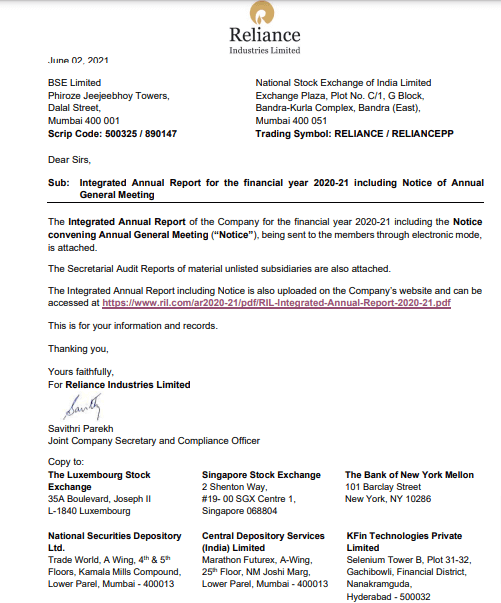
Example of Progress Report
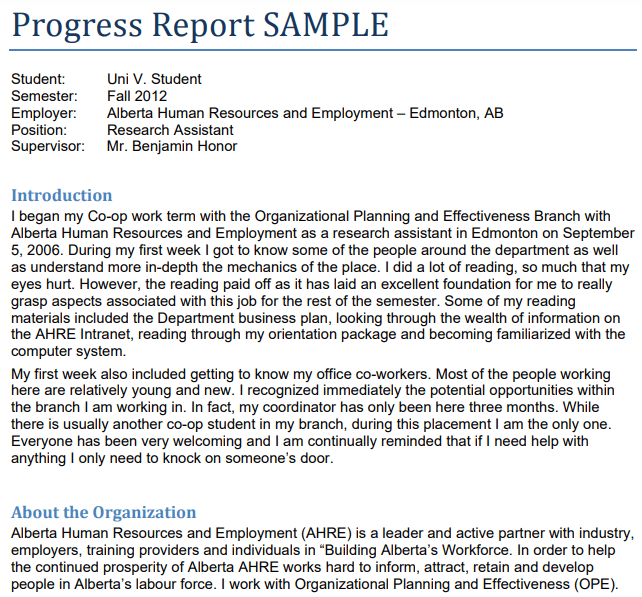
The essential process of report writing
Report writing requires careful planning, organization, and analysis to ensure that the report effectively communicates the intended message to the audience. Here are the general steps involved in the process of report writing:
Plan and prepare:
- Identify the purpose of the report, the target audience, and the scope of the report.
- Collect and examine data from different sources, including research studies, surveys, or interviews.
- Create an outline of the report, including headings and subheadings.
Write the introduction:
- Start with a brief summary of the report and its purpose.
- Provide background information and context for the report.
- Explain the research methodology and approach used.
Write the main body:
- Divide the report into logical sections, each with a clear heading.
- Present the findings and analysis of the research in a clear and organized manner.
- Use appropriate visual aids, such as tables, graphs, or charts to present data and information.
- Utilize a language that is both clear and Brief, and avoid using unnecessary jargon or technical terminology.
- Cite all sources used in the report according to a specified citation style.
Write the conclusion:
- Summarize the main findings and conclusions of the report.
- Restate the purpose of the report and how it was achieved.
- Provide recommendations or suggestions for further action, if applicable.
Edit and revise:
- Review the report for errors in grammar, spelling, and punctuation.
- Check that all information is accurate and up-to-date.
- Revise and improve the report as necessary.
Format and present:
- Use a professional and appropriate format for the report.
- Include a title page, table of contents, and list of references or citations.
- Incorporate headings, subheadings, and bullet points to enhance the report’s readability and facilitate navigation.
- Use appropriate fonts and sizes, and ensure that the report is well-structured and visually appealing.
Important Principles of report writing
To write an effective report, it is important to follow some basic principles. These principles ensure that your report is clear, concise, accurate, and informative. In this regard, here are some of the key principles that you should keep in mind when writing a report:
1/ Clarity: The report should be clear and easy to understand.
2/ Completeness: The report should cover all the relevant information needed to understand the topic
3/ Conciseness: A report should be concise, presenting only the information that is relevant and necessary to the topic.
4/ Formatting: The report should be properly formatted, with consistent fonts, spacing, and margins
5/ Relevance: The information presented in the report should be relevant to the purpose of the report.
6/ Timeliness: The report should be completed and delivered in a timely manner.
7/ Presentation: The report should be visually appealing and well-presented.
Extra Learnings
Styles of report writing
When it comes to the style of report writing, it’s important to use hard facts and figures, evidence, and justification. Using efficient language is crucial since lengthy reports with too many words are difficult to read. The most effective reports are easy and quick to read since the writer has comprehended the data and formulated practical recommendations.
To achieve this, it’s important to write as you speak, avoid empty words, use descending order of importance, use an active voice, and keep sentences short. The goal should be to write to express and not to impress the reader.
It’s also important to get facts 100% right and to be unbiased and open. By following these tips, one can create a well-written report that is easy to understand and provides valuable insights.
Differences between a report and other forms of writing
Reports are a specific form of writing that serves a distinct purpose and have unique characteristics. Unlike other forms of writing, such as essays or fiction, reports are typically focused on presenting factual information and making recommendations based on that information. Below we have differentiated report writing with various other forms of writing.
Essay vs report writing
Aspect | Essay Writing | Report Writing |
Purpose | To present an argument or analysis | To present data, findings, and recommendations |
Structure | Introduction, Body, Conclusion | Title page, Executive Summary, Introduction, Body, Conclusion |
Length | Shorter, typically 500 to 1,500 words | Longer, typically 1,500 to 10,000 words |
Tone | Persuasive, subjective | Objective, factual |
Referencing | May or may not include references | Always includes references and citations |
Project writing vs report writing
Aspect | Project Writing | Report Writing |
Purpose | To complete a task with a specific goal | To present data, findings, and recommendations |
Structure | Can vary, typically includes a proposal, methodology, results, and conclusions | Title page, Executive Summary, Introduction, Body, Conclusion |
Length | Longer, can range from a few pages to a book-length report | Longer, typically 1,500 to 10,000 words |
Audience | Can be internal or external stakeholders | Typically external stakeholders |
Tone | Objective, factual | Objective, factual |
Research methodology vs report writing
Aspect | Research Methodology | Report Writing |
Purpose | To explain the research process | To present data, findings, and recommendations |
Structure | Can vary, typically includes an introduction, literature review, methodology, results, and conclusions | Title page, Executive Summary, Introduction, Body, Conclusion |
Length | Longer, typically 3,000 to 10,000 words | Longer, typically 1,500 to 10,000 words |
Focus | Focuses on the methodology used in research | Focuses on the data and findings of research |
Tone | Objective, factual | Objective, factual |
Article writing vs report writing
Aspect | Article Writing | Report Writing |
Purpose | To inform, educate, or entertain | To present data, findings, and recommendations |
Structure | Can vary, typically includes an introduction, body, and conclusion | Title page, Executive Summary, Introduction, Body, Conclusion |
Length | Shorter, typically less than 2,000 words | Longer, typically 1,500 to 10,000 words |
Tone | Can be subjective, creative | Objective, factual |
Formatting | Often includes images and multimedia | Typically text-based |
Content writing vs report writing
Aspect | Content Writing | Report Writing |
Purpose | To provide relevant and valuable content | To present data, findings, and recommendations |
Structure | Can vary, typically includes an introduction, body, and conclusion | Title page, Executive Summary, Introduction, Body, Conclusion |
Length | Shorter, typically less than 1,500 words | Longer, typically 1,500 to 10,000 words |
Tone | Can be subjective, creative | Objective, factual |
Formatting | Often includes images and multimedia | Typically text-based |
Business plan vs report writing
Aspect | Business Plan Writing | Report Writing |
Purpose | To outline a company's goals, strategies, and financial projections | To present data, findings, and recommendations |
Structure | Can vary, typically includes an executive summary, company description, market analysis, organizational structure, financial projections, and conclusion | Title page, Executive Summary, Introduction, Body, Conclusion |
Length | Longer, typically 10 to 50 pages | Longer, typically 1,500 to 10,000 words |
Latest topics for report writing in 2024
The possibilities for report topics may depend on the goals and scope of the report. The key is to choose a topic that is relevant and interesting to your audience, and that you can conduct thorough research on in order to provide meaningful insights and recommendations.
- A market analysis for a new product or service.
- An evaluation of employee satisfaction in a company.
- A review of the state of cybersecurity in a particular industry.
- A study of the prevalence and consequences of workplace discrimination.
- Analysis of the environmental impact of a particular industry or company.
- An assessment of the impact of new technology or innovations on a particular industry or sector.
Report writing skills and techniques
Effective report writing requires a combination of skills and techniques to communicate information and recommendations in a clear, and engaging manner.
From organizing information to tailoring the report to the intended audience, there are many factors to consider when writing a report. By mastering these skills and techniques, you can ensure that your report is well-written, informative, and engaging for your audience. Some of the primary ones are:
1/ Organization and structure: Structure your report in a logical and organized manner with headings and subheadings.
2/ Use of data and evidence: Present objective data and evidence to support your findings and recommendations.
3/ Audience awareness: Tailor your report to the needs and interests of your intended audience.
4/ Effective visuals: Use graphs, charts, or other visuals to communicate complex information in a clear and engaging way.
5/ Editing and proofreading: Carefully edit and proofread your report to ensure it is error-free and professional.
6/ Tone: Use a professional and objective tone to communicate your findings and recommendations.
7/ Time management: Manage your time effectively to ensure you have enough time to research, write, and revise your report.
Tips for effective report writing
- Understand your audience before you start writing.
- Start with an outline and cover all the important points.
- Employ clear and concise language.
- Utilize headings and subheadings to organize your report.
- Incorporate evidence and examples to support your points.
- Thoroughly edit and proofread your report before submission.
- Follow formatting guidelines If your report has specific formatting requirements.
- Use visuals to enhance understanding.
What is the ethical consideration involved in report writing
Ethical considerations play a crucial role in report writing. The accuracy of the information presented in the report is of utmost importance, as it forms the basis for any conclusions or recommendations that may be made. In addition, it is essential to avoid plagiarism by giving credit to the original sources of information and ideas.
Another crucial ethical consideration is confidentiality, particularly when the report contains sensitive or confidential information. It is important to safeguard this information and prevent its disclosure to unauthorized individuals.
Avoiding bias in report writing is also crucial, as it is essential to present information in an objective and unbiased manner. In cases where research or data collection is involved, obtaining informed consent from human subjects is a necessary ethical requirement.
By taking these ethical considerations into account, report writers can ensure that their work is fair, accurate, and respectful to all parties involved.
Common mistakes in report writing
There are several common mistakes that students and report writers make in report writing. By avoiding these common mistakes, students as well as report writers can create effective and impactful reports that are clear, accurate, and objective.
1/ Writing in the first person: Often, students and report writers commit an error by writing in the first person and utilizing words such as “I” or “me. In reports, it is recommended to write impersonally, using the passive voice instead.
2/ Using the wrong format: Reports should use numbered headings and subheadings to structure the content, while essays should have a clear line of argument in their content.
3/ Failing to introduce the content: The introduction of the report should introduce the content of the report, not the subject for discussion. It is important to explain the scope of the report and what is to follow, rather than explaining what a certain concept is.
4/ Missing relevant sections: Students and report writers, often miss out on including relevant sections that were specified in the assignment instructions, such as a bibliography or certain types of information. This can result in poor interpretation.
5/ Poor proofreading: Finally, not spending enough time proofreading the reported work can create unwanted mistakes. Therefore, It is important to proofread and correct errors multiple times before submitting the final report to avoid any mistakes that could have been easily corrected.
By avoiding these common mistakes, students and report writers can improve the quality of their reports.
What are some challenges of report writing and how to overcome them
Report writing can be a challenging task for many reasons. Here are some common challenges of report writing and how to overcome them:
1/ Lack of clarity on the purpose of the report: To overcome this challenge, it is important to clearly define the purpose of the report before starting. This can help to focus the content of the report and ensure that it meets the needs of the intended audience.
2/ Difficulty in organizing ideas: Reports often require a significant amount of information to be organized in a logical and coherent manner. To overcome this challenge, it can be helpful to create an outline or flowchart to organize ideas before beginning to write.
3/ Time management: Writing a report can be time-consuming, and it is important to allow sufficient time to complete the task. To overcome this challenge, it can be helpful to create a timeline or schedule for the various stages of the report-writing process.
4/ Writer’s block: Sometimes writers may experience writer’s block, making it difficult to start or continue writing the report. To overcome this challenge, it can be helpful to take a break, engage in other activities or brainstorming sessions to generate new ideas.
5/ Difficulty in citing sources: It is important to properly cite sources used in the report to avoid plagiarism and maintain credibility. To overcome this challenge, it can be helpful to use citation management tools, such as EndNote or Mendeley, to keep track of sources and ensure accurate referencing.
6/ Review and editing: Reviewing and editing a report can be a challenging task, especially when it is one’s own work. To overcome this challenge, it can be helpful to take a break before reviewing the report and seek feedback from others to gain a fresh perspective.
By being aware of these challenges and taking proactive steps to overcome them, report writers can create effective and impactful reports that meet the needs of their intended audience.
Best Software for writing reports
Report writing software has made it easier for writers to produce professional-looking reports with ease. These software tools offer a range of features and functionalities, including data visualization, collaboration, and customization options. In this section, we will explore some of the best report-writing software available:
1/ Tableau: This tool is great for creating interactive and visually appealing reports, as it allows users to easily create charts, graphs, and other data visualizations. It also supports data blending, which means that you can combine data from multiple sources to create more comprehensive reports.
2/ Zoho reporting: This tool is designed to help users create and share professional-looking reports quickly and easily. It offers a variety of customizable templates, as well as a drag-and-drop interface that makes it easy to add data and create charts and graphs.
3/ Bold Reports by Syncfusion: This tool is designed specifically for creating reports in .NET applications. It offers a wide range of features, including interactive dashboards, real-time data connectivity, and customizable themes and templates.
4/ Fast Reports: This tool is a reporting solution for businesses of all sizes. It allows users to create reports quickly and easily using a drag-and-drop interface and offers a variety of templates and customization options. It also supports a wide range of data sources, including databases, spreadsheets, and web services.
Further Reading: 10+ Best Report Writing Software and Tools in 2024
What is the conclusion of report writing
The conclusion of report writing is the final section of the report that summarizes the main findings, conclusions, and recommendations. It should tie together all the different sections of the report and present a clear and concise summary of the key points.
THE UNIVERSITY OF NEWCASTLE has given an inverted introduction framework that can use used for writing effective conclusions for reports.
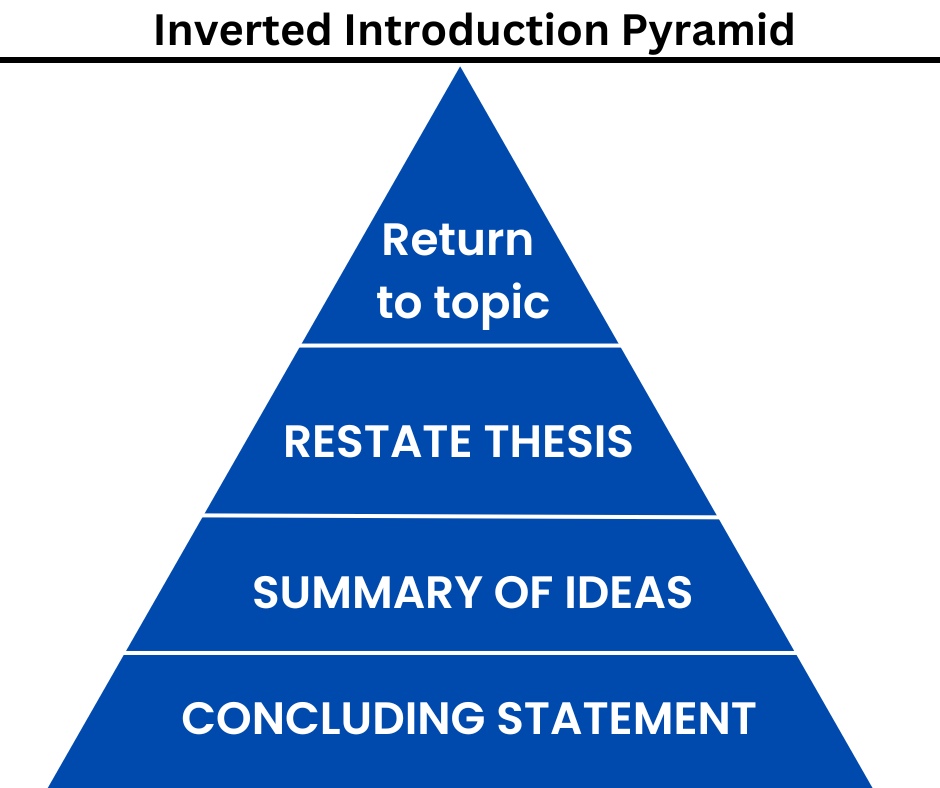
Example of conclusion in report writing:
The implication of the above diagram can be explained with the following example:
1. RETURN TO TOPIC:
Social media has revolutionized the marketing landscape, providing new opportunities for brands to connect with their target audience.
2. RESTATE THESIS:
However, the complexities and limitations of social media mean that it is unlikely to completely replace traditional marketing methods. The role of the marketing professional remains crucial in ensuring that social media strategies align with the company’s overall goals and effectively reach the desired audience.
3. SUMMARY OF IDEAS DISCUSSED:
Automated tools cannot fully account for the nuances of human communication or provide the level of personalization that consumers crave. Therefore, the most effective marketing strategies will likely blend social media tactics with traditional marketing channels.
4. CONCLUDING STATEMENT [restating thesis]:
In conclusion, while social media presents significant opportunities for brands, the expertise of marketing professionals is still essential to creating successful campaigns that achieve desired outcomes.
Frequently Asked Questions
Q1) What is report writing and example?
Ans: Report writing involves preparing a structured document that delivers information to a particular audience in a clear and systematic manner. An example of a report could be a business report analyzing the financial performance of a company and making recommendations for improvement.
Q2) What is report writing and types of reports?
Ans: The act of presenting information in an orderly and structured format is known as report writing. Reports come in different types, such as analytical reports, research reports, financial reports, progress reports, incident reports, feasibility reports, and recommendation reports.
Q3) What are the 5 steps of report writing
The five steps of report writing, are as follows:
- Planning: This involves defining the purpose of the report, determining the audience, and conducting research to gather the necessary information.
- Structuring: This step involves deciding on the structure of the report, such as the sections and subsections, and creating an outline.
- Writing: This is the stage where the actual writing of the report takes place, including drafting and revising the content.
- Reviewing: In this step, the report is reviewed for accuracy, coherence, and effectiveness, and any necessary changes are made.
- Presenting: This final step involves presenting the report in a clear and professional manner, such as through the use of headings, visuals, and a table of contents.
Q4) What is a report in short answer?
Ans: A report is a document that presents information about a specific subject or topic in an organized and structured format. It can be written for a variety of purposes, such as to inform, analyze, or persuade a specific audience. Reports typically include an introduction, main body, and conclusion, and may also include tables, graphs, and other visual aids to enhance the presentation of data.

